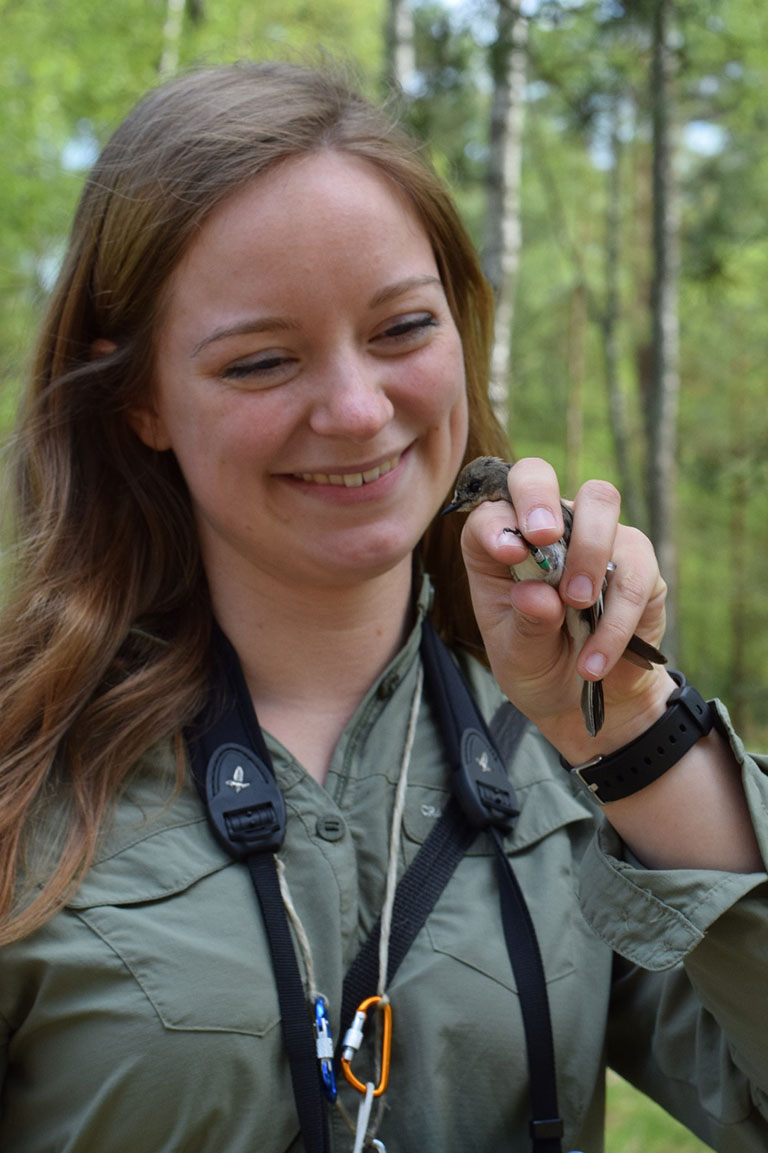 Nest boxes provide breeding grounds for pied flycatchers in the Swedish forest. Photo credit: Koosje Lamers
Nest boxes provide breeding grounds for pied flycatchers in the Swedish forest. Photo credit: Koosje LamersOver the course of three years, Lamers rode her bike over thawing ground listening for bird calls. She saw more and more Dutch birds populating the Swedish forests, and they usually got there first. Location data from tiny backpack trackers confirmed that the Dutch flycatchers left their wintering sites in Africa first, while the Swedish natives left later.
Because the Dutch birds timed their arrival to the early-spring peak of caterpillar supplies, their babies had no shortage of food. In this way, said Lamers, southern populations of flycatchers can act as a kind of “genetic reserve.” The new migratory destination encoded in their DNA might help the species adapt to climate change.
 A mother bird steps aside to show freshly hatched chicks and the remaining eggs in her nest. Photo credit: Koosje Lamers
A mother bird steps aside to show freshly hatched chicks and the remaining eggs in her nest. Photo credit: Koosje Lamers
Migratory bird expert Carlos Camacho at Estación Biológica de Doñana in Seville, Spain, described the team’s approach as “risky” and “groundbreaking.” He praised the originality of the experiment but was hesitant to draw conclusions just yet. The distance researchers transported the birds is farther than most species would move on their own, he noted. Still, Camacho was optimistic.
“Perhaps it’s not necessary that one individual perform the whole large movement,” he told Mongabay. Gradual migration over many generations might also have advantages, Camacho said.
“Dispersal occurs naturally and successfully on smaller scales,” wrote Lamers in an email to Mongabay, referring to a species migrating to new spots. “Even this, we argue, can contribute to adaptation.” As the consequences of climate change become more apparent, so too do the clever strategies animals must employ to survive.
 Conservation ecologist Koosje Lamers smiles at a pied flycatcher. Photo credit: Koosje Lamers
Conservation ecologist Koosje Lamers smiles at a pied flycatcher. Photo credit: Koosje Lamers
Citation:
Lamers, K.P., Nilsson, J.-Å., Nicolaus, M., and Both, C. Adaptation to climate change through dispersal and inherited timing in an avian migrant. Nature Ecology & Evolution 7, 1869–1877 (2023). doi: 10.1038/s41559-023-02191-w
Gillian Dohrn is a graduate student in the Science Communication M.S. Program at the University of California, Santa Cruz. Other Mongabay stories produced by UCSC students can be found here.
Source link : https://news.mongabay.com/2023/11/ecologists-help-migratory-birds-adapt-to-climate-change/
Author :
Publish date : 2023-11-30 08:00:00
Copyright for syndicated content belongs to the linked Source.


